Who is Robert Peary? The biography of this man is a fascinating reading. A talented engineer and Arctic explorer, he was the first to reach the northernmost point of the Earth. On his account there are many geographical discoveries and scientific works, but in history he will forever remain the conqueror of the North Pole.
Childhood and early years
On May 6, 1856, a child was born into a wealthy American family called Peary. The boy was named Robert Edwin, he was the only son of Charles Nutter Peary, a well-known barrel maker in the area.
The early years were overshadowed by the sudden death of his father: he died of pneumonia when Robert was not even 3 years old. The elder Piri left his orphaned family with a fairly good inheritance of 12 thousand dollars at that time, so that after his death the widow and child were not particularly poor.
Soon, Robert's mother decided to move from his hometown of Cresson (Pennsylvania) closer to relatives in Maine, where he spent his childhood and adolescence.
A strong-willed character, activity, craving for books and natural sciences manifested itself in him already in his school years: Robert Peary was considered one of the first fighters, and at the same time a very diligent and successful student.
After completing his secondary education, young Piri continued his studies at Bowdeen College, where he easily mastered the profession of a civil engineer.
Service and finding yourself
Like many great people, young Robert Peary was tormented by the choice of a life path and dreams of future achievements. The calm, measured life of an ordinary engineer did not appeal to him.
Feeling deeply dissatisfied, he fell into depression for a long time, as evidenced by the entries in his diary and correspondence with a school friend, Robert's first love.
After college, he settled with his mother in the town of Freiberg, where he worked as a land surveyor. There he became engaged to a certain Laura Harmon, but the matter never came to a wedding. Soul searches still haunted, the young specialist tried himself in cartography, but after working for 1.5 years in the US Coastal and Geodetic Service, he nevertheless resigned.
Hoping for a more interesting job, Robert Peary embarked on a career in the US Navy. After passing the required exams, he received the rank of lieutenant and a place in the Corps of Civil Engineers.
His work at that time was directly related to the specialty he received in college: Peary took part in the construction of the pier in Key West (1882), worked in Nicaragua as a deputy chief engineer for the exploration of the transoceanic canal route (1884).
Polar explorer is a vocation
The purchase of a book about the polar expedition of the famous American traveler Eliasha Kane turned the whole life of a seemingly successful military engineer upside down. Letters to his mother and his diaries were saturated with ideas about how to perpetuate his own name, and about the chosen way to achieve this goal - new expeditions to the North and, of course, about future discoveries.
First expedition
Having "got sick" with the Arctic finally and irrevocably, Piri draws up his leave and leaves for Greenland, without having any specific purpose and route. His mother was one of the sponsors of the expedition, giving his son $ 500, which was enough to sail to the town of Qeqertarsuaq in Disko Bay.
The company Robert Peary decided to make up the vice-governor of the small settlement of Ritenbank - Christian Maygor.
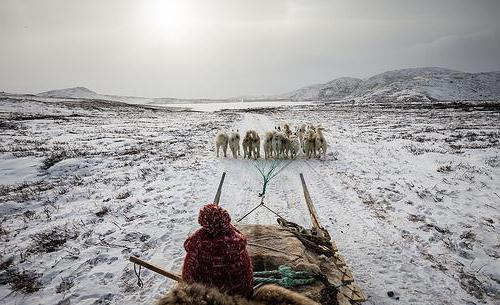
On June 28, 1886, they set out inland on two sleighs, accompanied by 8 local Eskimos. The weather turned out to be extremely warm, so to speak about the northern summer: sleet and stormy winds impeded travel on the harsh Greenland land. In total, Piri and Maigor walked about 160 km and turned back, since the provisions remained only for 6 days. They covered the way back in a fair wind twice as fast.
The first Arctic experience, no matter how difficult it was, only confirmed Robert Peary in the correctness of the chosen path.
During his life, this indefatigable American made 8 expeditions to Greenland. He made many amazing discoveries and more than once was on the verge of death. Having visited the Arctic for the first time, he managed to fall into an ice crevice and miraculously survived, catching himself on the edge of the sled.

During his second expedition to northeastern Greenland (1891-1892), he covered a distance of 2,100 km on sleds. The result of this sledging campaign was the discovery of new lands of Melville and Haleprin. At the same time, Robert Peary told the world that Greenland is actually an island.
One of the polar voyages (1894) was dedicated to Cape York, where a team of researchers was searching for iron meteorites. An interesting fact is that one of the Eskimos showed the way to the place where Piri fell in exchange for a revolver.
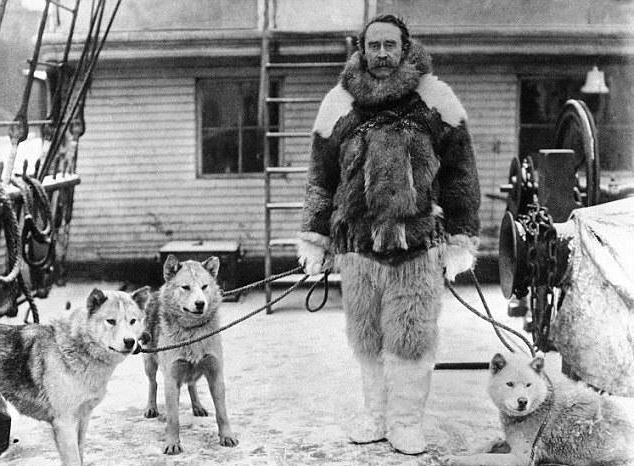
The largest of the wreckage weighed almost 31 tons and was named Anigito. The meteorite owes its strange name to Piri's little daughter, Mary, who was entrusted to smash a bottle of wine on a space block when she was loaded onto a ship. To celebrate, the girl shouted out an insignificant set of letters, which later became the name of the find.
The North Pole has been conquered!
Geographical discoveries, exploration of glaciers, scientific works - all this was not enough. The most important thing Robert Peary has dreamed of all his life is the North Pole. A reserved and cruel land, hitherto not conquered by anyone.
There were three attempts to reach the pole, and only the last one was crowned with success. She was sponsored by the US Navy, and Peary was accompanied on the voyage by his close friend, Theodore Roosevelt. It is worth noting that at that time the head of the expedition was already over 50.
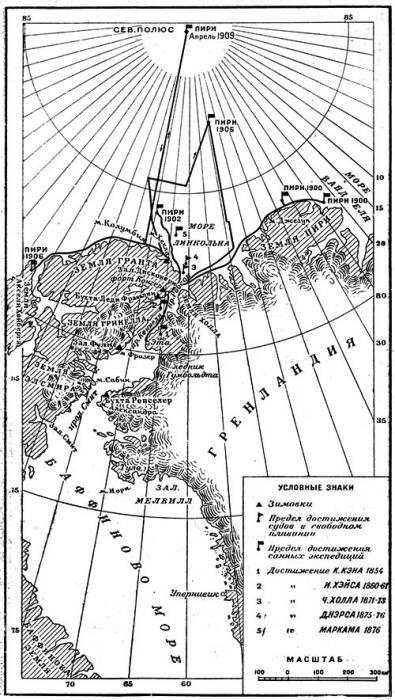
On June 6, 1908, the Roosevelt left the docks of New York and headed north. On the way to the cherished goal, Piri made stops: stocked up on provisions, took on board sled dogs and Eskimos who willingly joined the expedition.
On March 1, 1909, leaving the ship at Cape Columbia, Peary with a team of 24 people went to the North Pole on dogs. The long journey through the ice, in spite of the scorching wind and frost at -50 ° C, is worthy of a separate book. Many dogs have died, many people have become desperate.
The last, final transition Peary made in the company of his faithful assistant Matthew Henson and 4 Eskimos. On April 6, 1909, having determined their exact location, the polar explorers realized that they had reached their goal.
What emotions can a person experience at the same time? They can only be compared with the excitement of a mother who has just given birth to a healthy child, or with the joy of soldiers who were informed of victory and an imminent return home.
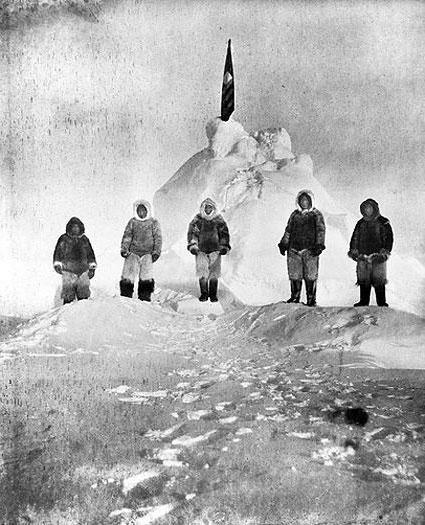
Peary and five of his men stayed at the pole for about 30 hours. As they left, they planted the US flag and took a commemorative photo.
Championship disputes
On the way back, it became known that not only Robert Peary claims the title of the conqueror of the North Pole, that he opened it second, a year later than Frederick Cook.
They had known each other since the time of Piri's second expedition, in which his opponent took part in the role of a doctor.
Cook did not have any weighty and indisputable evidence, and he lost the dispute about the North Pole. Piri was awarded a gold medal, an individual pension of $ 5,625, and the title of Rear Admiral.
Family, children, descendants
For many years, his faithful wife, Josephine (nee Diebitsch), was next to the great polar explorer. He met her back in 1882, in Washington, at a dance lesson. The young lady was then only 19 years old. They got married 6 years after they met - in 1888.
The daughter of the Piri couple was born in the harsh conditions of one of the expeditions. The Eskimos, which were part of it, called the baby "snow child" for a porcelain skin tone unprecedented in the north. The second daughter, Frencine, who was born on the mainland, died at the age of 7 months from an intestinal infection. Robert and Josephine also had a son named exactly like the father.
Piri could not be called an exemplary husband: being on another northern campaign, he lived for two years with a local Eskimo with the hard-to-pronounce name Allakasingwa. They had a common child, whose descendants still live in Greenland.
Robert Peary died in 1920 of leukemia, Josephine survived him by as much as 35 years.
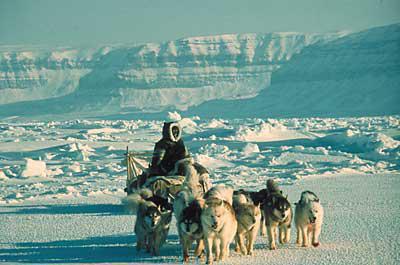
An educated, wealthy person with a good salary, he could lead an idle and useless life, in this case, after death, only the caretaker of the cemetery in which he is buried would remember his name.
But Robert Peary was not like that. Photos of his northern wanderings, entries in diaries and stories of associates once again confirm that nothing is impossible for a person. At the cost of incredible efforts and great willpower, he inscribed his name in the annals of history with a firm handwriting, as the man whose foot was the first to leave a mark on the North Pole of the Earth.




